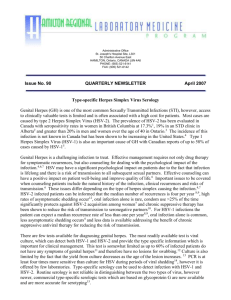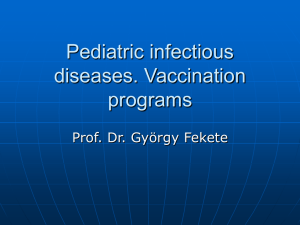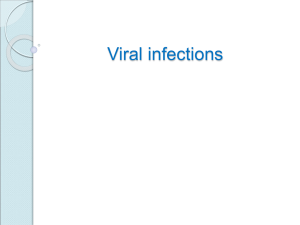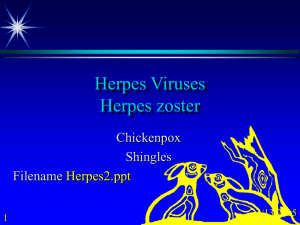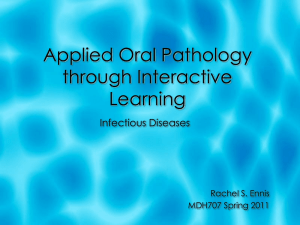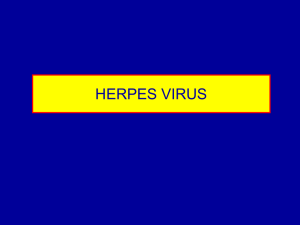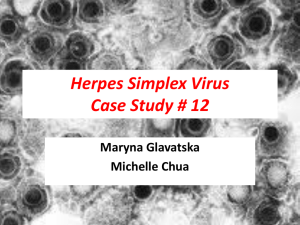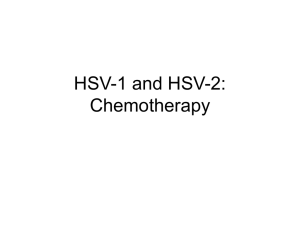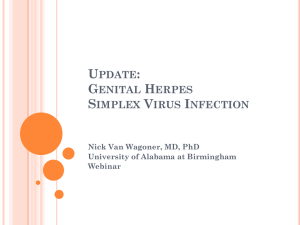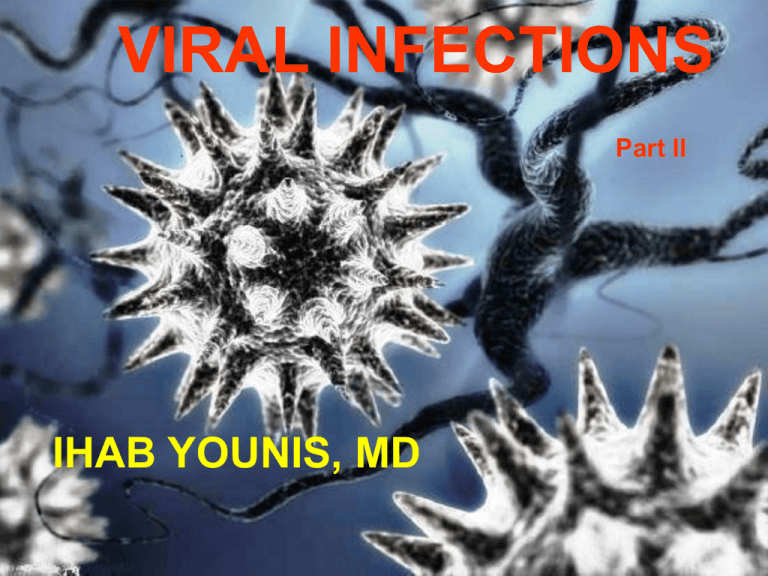
VIRAL INFECTIONS
Part II
IHAB YOUNIS, MD
Herpes simplex
Etiology
• HSV(types 1&2) is a double-stranded DNA virus
• Characterized by:
1-Neurovirulence:the capacity to invade and
replicate in nerves
2-Latency: latent infection in sensory nerve
ganglia
3-Reactivation:induced by a variety of
stimuli
(eg, fever, trauma, emotional stress,
sunlight, menstruation)
Clinically
1- Acute herpetic gingivostomatitis
• Occurs in children aged 6 months to 5 years
• Mode of infection: Infected saliva from an
adult or another child
• The incubation period : 3-6 days
• Abrupt onset ,high temperature, anorexia
and listlessness
• Gingivitis: swollen, erythematous, friable
gums
• Vesicular lesions: on the oral mucosa,
tongue, lips and later rupture and coalesce,
leaving ulcerated plaques
• Tender regional lymphadenopathy
• Perioral skin also may be involved because
of contamination with infected saliva
Course
• Acute disease lasts 5-7 days
• Symptoms subside in 2 weeks
• Viral shedding from the saliva may continue
for 3 weeks or more
2-Acute herpetic pharyngotonsillitis
• In adults, oropharyngeal HSV-1 causes pharyngitis
and tonsillitis more often than gingivostomatitis
• Fever, malaise, headache and sore throat
• Vesicles rupture to form ulcerative lesions with
grayish exudates on the tonsils& posterior pharynx
• Less than10% have associated oral & labial lesions
• HSV-2 can cause similar symptoms and is associated
with orogenital contact or can occur concurrently with
genital herpes
3-Recurrent Herpes labialis
• A prodrome of pain, burning & tingling
• Followed by the development of erythematous
papules that rapidly develop into tiny, thin-walled,
intraepidermal vesicles that become pustular and
ulcerate
• In most patients, fewer than 2 recurrences each year,
but some individuals have monthly recurrences
• Maximum viral shedding is in the first 24 hours of the
acute illness but may last 5 days.
•
•
•
•
•
•
•
4-Primary genital herpes
Primary genital herpes can be caused by both HSV-1
and HSV-2
Recurrences are more common with HSV-2
Asymptomatic in most patients
Primary genital herpes is characterized by severe
and prolonged systemic and local symptoms. The
symptoms of persons with a first episode of
nonprimary HSV-2 infection are less severe and of
shorter duration
Preexisting antibodies to HSV-1 have an ameliorating
effect on disease severity caused by HSV-2
Prior orolabial HSV-1 protects against genital HSV-1
but not HSV-2
Women's symptoms are more severe and women
have a higher rate of complications than men
•
•
•
•
Clinical features in men
Herpetic vesicles appear in the glans penis, the
prepuce, the shaft of the penis, and sometimes on the
scrotum, thighs, and buttocks
In dry areas, the lesions progress to pustules and then
crust
Herpetic urethritis occurs in 30-40% of patients and is
characterized by severe dysuria and mucoid discharge
The perianal area and rectum can be involved in persons
who engage in anal intercourse, resulting in herpetic
proctitis.
•
•
•
•
Clinical features in women
Herpetic vesicles appear on the external
genitalia, labia majora, labia minora, vaginal
vestibule, and introitus
In moist areas, the vesicles rupture, leaving
exquisitely tender ulcers
The vaginal mucosa is inflamed and
edematous. The cervix may be involved in 7090% of patients
Dysuria may be very severe and may cause
urinary retention
• In men and women, the ulcerative lesions
persist from 4-15 days until crusting and
reepithelialization occur
• The median duration of viral shedding is
about 12 days.
5-Recurrent genital herpes
•
•
•
•
•
•
60% of patients with 1ry genital HSV-2 have recurrences in the 1st
year
38% had 6 recurrences/year and 20% had more than 10
recurrences
Both subclinical and symptomatic reactivation are more common
with HSV-2 compared to HSV-1
Recurrent genital herpes is preceded by a prodrome of tenderness,
pain, and burning at the site of eruption that may last from 2 hours to
2 days
Pain is mild, and lesions heal in 7-10 days and constitutional
symptoms are uncommon. The lesions heal in 8-10 days and viral
shedding lasts an average 5 days
The symptoms are more severe in women than men
Subclinical genital herpes
• The majority of primary genital HSV infections
are asymptomatic and 70%-80% of seropositive
individuals have no history of symptomatic
genital herpes Nevertheless, they experience
periodic subclinical reactivation with virus
shedding, thus making them a source of
infection
• The rate of viral shedding may be 1-2% . This
fact is important in neonatal herpes because
most mothers have no signs and symptoms of
genital herpes during pregnancy
Histopathology
•Epidermal spongiosis
•Intraepidermal vesicle
formation
• Dermal inflammatory
infilt
Investigations
• HSV infection is best confirmed by isolation of
virus in tissue culture
• Immunofluorescent staining of the tissue
culture cells can quickly identify HSV and
can distinguish between types 1 and 2
• Rapid detection of HSV DNA in clinical
specimens is now possible with polymerase
chain reaction (PCR)
• Antibody testing can demonstrate a primary
seroconversion, particularly with HSV-1 in
childhood
– Because of sero–cross-reactivity, HSV-1 and
HSV-2 are not generally distinguishable
unless a glycoprotein G antibody assay is
available
– Antibody titer increases generally do not
occur during recurrences of HSV.Therefore,
the test generally is not used for the diagnosis
of mucocutaneous HSV relapse
• Tzanck smear is a time-honored procedure to
assist in the diagnosis of cutaneous
herpesvirusinfections
• Typically, an intact vesicle is used from which
the vesicular fluid is aspirated
• After aspiration, the vesicle should be unroofed
aseptically.Using a sterile instrument, the floor of
the newly produced ulcer can then be scraped.
The obtained material can be spread on a glass
microscope slide and then dried and fixed for
staining
• Staining can be performed
with a Papanicolaou stain,Gram or Giemsa
• A positive result is the finding of
multinucleate giant cells.
• Using appropriate immunofluorescent
antibody reagents, the smear can
distinguish different herpesviruses and
nonherpesviruses that may be present (eg,
vaccinia, smallpox)
Treatment
• 1-Acyclovir (Acyclovir cream, zovirax,
Lovir 400 mg tab))
• Inhibits the thymidine kinase of herpes
viruses
• Evidence from multiple clinical trials shows
that topical acyclovir has little or no
therapeutic effect
•
Oral Dose:
-First episode mucocutaneous herpes simplex:
400 mg tid for 7-10 d or until clinical resolution
- Recurrent genital herpes: 200 mg PO five
times daily for 5 d
-Chronic suppressive therapy: 400 mg bid or
200 mg 3-5 times daily; reevaluate after 1 y
2-Valacyclovir (Valtrex):
• Prodrug rapidly converted to the active drug
acyclovir. More expensive but has a more
convenient dosing regimen
• Dose:
-First episode: 1 g bid for 10 d
-Recurrent episode : 500 mg bid for 5 d
beginning within 24 h of onset
-Suppressive dosing for HSV: 500 mg to 1 g/d
3-Famciclovir (Famvir)
• Prodrug that when biotransformed into
active metabolite, penciclovir
• Inhibits viral DNA synthesis/replication
• Dose:
-Recurrent genital HSV: 125 mg bid for 5 d
-Suppression of frequent recurrence of
genital HSV: 250 mg bid up to 12 mo
Eczema herpeticum
Etiology
• It is caused by a disseminated HSV
infection in patients with atopic dermatitis
• Patients have cell-mediated and humoral
defects
• A disorder of infants& children of any age
• Occurs occasionally in adults
• Umbilicated vesiculopustules that progress to
punched-out erosions
• The eruption is most commonly disseminated in
the areas of dermatitis, with a predilection for
the head & trunk. Localized forms also exist
• The vesicles often become hemorrhagic and
crusted and can evolve into extremely painful
erosions with a punched-out appearance
• These erosions may coalesce to form large,
denuded areas that frequently bleed and can
become secondarily infected with bacteria
• The eruption continues to spread over 710 days and may be associated with a
high temperature, malaise, and
lymphadenopathy
• Recurrent episodes may also occur but
are milder and not usually associated with
systemic symptoms
Eczema herpeticum
Treatment
• Acyclovir IV or orally
• Eczema treated as usual but steroids are
used cautiously
• Patients with atopic dermatitis should be
aware of herpetic infection
Herpes zoster
(Shingles)
Zoster=girdle
Etiology
• VZV is a double-stranded DNA virus
• Infection initially produces chickenpox. Following
resolution of the chickenpox, the virus lies
dormant in the dorsal root ganglia until focal
reactivation along a ganglion's distribution
results in herpes zoster
• Although the exact precipitants that result in viral
reactivation are not known certainly, decreased
cellular immunity appears to increase the risk of
reactivation.
• Regarding primary infection, more than
90% of the population is infected by
adolescence, and approximately 100% are
infected by 60 years of age
• Herpes zoster affects about 10-20% of the
population
Clinically
• A prodrome (pain,fever, malaise, headache, and
dysesthesia) occurs 1-4 days before the
development of the cutaneous lesions
• Grouped vesicles, usually involving 1, but
occasionally up to 3, adjacent dermatomes
• Vesicles become pustular, and occasionally
hemorrhagic, with evolution to crusts in 7-10
days
• Pain may subside in 2-3 w in young patients but
may last for 1 m in the elderly
• Pain lasting longer than 1-3 months is referred
to as postherpetic neuralgia. It affects 10-15%
• Its incidence & severity increase with age
• Types:
-Continuous burnning with allodynia
-Spasmodic shooting
-Crawling pruritus
• Herpes zoster ophthalmicus
– Vesicular rashes involving the ophthalmic division of the
trigeminal nerve. Crusting begins on the fifth to sixth day
– Hutchinson sign: severe ocular complications can occur with a
vesicular rash anywhere on the forehead
• Herpes zoster oticus
– Vesicles involve the external auditory canal, concha, and pinna,
postauricular skin, lateral nasal wall, soft palate, and
anterolateral tongue
– Vertigo and sensorineural hearing loss and/or paralysis of the
facial nerve may be noted
– Clinically, total loss of the ability to wrinkle the ipsilateral brow
differentiates a peripheral seventh nerve lesion from a central
seventh nerve lesion, which spares the forehead
Treatment
1-Antivirals:should start within 1-2 d
-Acyclovir 800 mg orally 5 times/d. for 7-10 d
-Valacyclovir 1gm orally q8h for 7 d
- Famciclovir (Famvir) 500 mg PO q8h for 7 d
2-Analgesics
3-?Prednisolone 60 mg/d orally tapered over 3 wk
• For postherpetic neuralgia:
I- For stabing pain : Anticonvulsants:
1-Gabapentin (Neurontine,Gaptin,Conventine)
400-1200 mg orally 3 tds
2-Phenytoin (Dilantin)100 to 300 mg orally at
bedtime; increase dosage until response is
adequate
3-Carbamazepine (Tegretol)100-200 mg orally
1-3 times/day
II- For burning pain :Tricyclic antidepressants:
1-Amitriptyline (Tryptizol 10mg Tab ) 25 mg
orally tds
2-Imipramine (Tofranil 25 mg tab)25 mg orally
1-6 times/d
Investigations
• Tzanck smear
• Biopsy is required for definitive diagnosis
• PCR
• Immunologic tests for viral antigen
– Direct immunofluorescence or
immunoperoxidase stains
– Radioimmunoassay
– Enzyme-linked immunosorbent assay
– Agar gel immunodiffusion
– Immunoelectrophoresis
• Serology for VZV antibodies
– Neutralizing or complement-fixing antibody
tests
– Enzyme-linked immunosorbent assay
– Radioimmunoassay
– Membrane antigen immunofluorescence
– Immune adherence hemagglutination
Chickenpox
(Varicella)
Etiology
• The varicella-zoster virus enters through the
respiratory system &by direct contact
• The virus replicates in regional lymph nodes
• After a week, a secondary viremia disseminates
the virus to the viscera and skin
• Varicella is highly contagious; secondary attack
rates range from 80-90% for household contacts
• Varicella's infectious period begins 2 days
before skin lesions appear and ends when the
lesions crust, usually 5 days later
Clinically
• Incubation period: 10-21 days
• Prodrome : Low-grade fever, abdominal
pain, cough and coryza preced skin
manifestations by 1-2 days
• Fever usually is low-grade and subsides
within 4 days
• Rash
– The characteristic rash appears in crops
– There are 250-500 lesions but can be as few
as 10
– Lesion starts as a red macule, rapidly
develops into papule, vesicle, pustule and
crust
– Varicella's hallmark is the simultaneous
presence of different stages of the rash
– Rash is centripetal starting on the back
– New lesions continue to erupt for 3-5 days,
crust by 6 days and heal completely by 16
days
Investigations
• Laboratory studies are unnecessary for
diagnosis because varicella is obvious clinically
• Serology is used to confirm past infection to
assess a patient's susceptibility status. This
helps determine preventive treatment
requirements for an adolescent or adult who has
been exposed to varicella
• The most sensitive test is the indirect fluorescent
antibody (IFA)
In-Utero Infections
1-Congenital varicella syndrome
• Occurs in 2% of children born to women who
develop varicella during the first or second
trimester
• Manifests as intrauterine growth retardation,
microcephaly, cortical atrophy, limb hypoplasia,
eye abnormalities and cutaneous scarring
• Fetal injury risk is unrelated to the severity of
disease in the mother
• Zoster exposure during pregnancy has not been
associated with fetal injury
2-Infantile zoster:
• Manifests within the first year
• The cause is maternal varicella infection
after the 20th week of gestation
• Commonly involves the thoracic
dermatomes
3-Neonatal varicella
• If the mother develops varicella within 5 days
before delivery,the baby acquires the virus
transplacentally but acquires no protective
antibodies because of insufficient time for
antibodies to develop in the mother
• In these circumstances, neonatal varicella is
likely to be severe and disseminated
• Prophylaxis or treatment is required with
varicella-zoster immune globulin (VZIG) and
acyclovir. Without these drugs, mortality rates
may be as high as 30%. The primary causes of
death are severe pneumonia and fulminant
hepatitis
Treatment
• Pruritus is managed with cool compresses
and regular bathing
• Scratching is discourage to avoid scarring
• Antivirals in adults
Varicella vaccination
• Vaccine was licensed for use in Japan and
Korea in 1988 and in the USA in 1995
• It is a live attenuated vaccine
• It is given to all infants and to older
children&adultss who have never had
chickenpox
• one dose until age 13
• Later two doses of vaccine are needed,
given 4-8 weeks apart
• 99% develop immunity after the
recommended two doses
• It is still 70-100% effective if given within
72 hours of infection
• The special "zoster vaccine" may be
available in 2006 to prevent herpes zoster
• In the USA chickenpox cases and
complications of chickenpox have declined
by more than 80% compared to 1995
Rubella
(German Measles)
“little red”
Etiology
• Rubella virus:a single-stranded RNA
• Portal of entry: respiratory epithelium of
the nasopharynx
• This is followed by a viremia that occurs
6-20 days after infection
Clinically
Postnatal rubella :
• Incubation period: 14-21 days
• Prodromal symptoms are unusual in young
children but are common in adolescents and
adults
• The exanthem of rubella consists of a discrete
rose-pink maculopapular rash ranging from 1-4
mm.
• Rash in adults may be quite pruritic
• The synonym “3-day measles” derives
from the typical course of rubella
exanthem that starts initially on the face
and neck and spreads centrifugally to the
trunk and extremities within 24 hours. It
then begins to fade on the face on the
second day and disappears throughout the
body by the end of the third day
• Temperature: Fever usually is not higher
than 38.5°C
• Lymph nodes: Enlarged posterior auricular
and suboccipital lymph nodes are usually
found on physical examination
• The Forchheimer sign(pinpoint or larger
petechiae that usually occur on the soft
palate) may still be present on the soft
palate
Congenital rubella:
The classic triad presentation of congenital rubella
syndrome consists of the following:
• Sensorineural hearing loss is the most common
manifestation
• Ocular abnormalities including cataract, infantile
glaucoma, and pigmentary retinopathy occur in
approximately 43%
• Congenital heart disease including PDA and
pulmonary artery stenosis is present in 50%
Investigations
1-Isolation of rubella-specific IgM antibodies in
serum using ELISA
2-Culture using African green monkey kidney cells
•
It is expensive, time consuming & not readily
available
•
It is the preferred technique in congenital
rubella syndrome because rubella serology
may be difficult to interpret in view of
transplacental passage of rubella-specific
maternal IgG antibody
Immunization
• A single dose confers long-term immunity,
probably lifelong immunity, against clinical and
asymptomatic infection in more than 90% of
immunized persons.
• It is given as the MMR immunization:
-The first dose is received at age 12-15
months
-The second dose is received at age 4-6
years
Measles(rubeola)
• Measles was the first exanthem described historically
• Measles has been called the greatest killer of children in
history
• Despite the availability of an effective vaccine for more
than 30 years , the measles virus still affects 50 million
people annually and causes more than 1 million deaths
• Measles was the first exanthem described historically
• Measles has been called the greatest killer of children in
history
• Despite the availability of an effective vaccine for more
than 30 years , the measles virus still affects 50 million
people annually and causes more than 1 million deaths
Etiology
• The measles virus is a single stranded RNA
virus
• Initially infects the respiratory epithelium and is
transmitted via respiratory droplets
• Replication in regional lymph nodes eventually
leads to viremia
• Infection with the measles virus leads to a
prolonged immunosuppression, which accounts
for much of the morbidity and mortality
associated with this disease
Clinically
• incubation period of 7-14 days
• The prodrome:
– The 3 C's of measles: cough, coryza &
conjunctivitis
– Fever and photophobia
– These symptoms increase in severity up to
3-4 days prior to the onset of the morbilliform
rash
• The enanthem (Koplik spots) predates the
exanthem by 24-48 hours and last
approximately 2-4 days
– These blue-white spots, surrounded by a red
halo
– They appear on the buccal mucosa opposite
the premolar teeth and are pathognomonic for
measles
• The exanthem itself begins on the fourth or fifth
day following the onset of symptoms.
– The rash appears as slightly elevated papules
0.1-1 cm in diameter that begin on the face
and behind the ear. It spreads to the entire
trunk and the extremities
– Initially, the color is dark red and reaches its
maximum intensity in approximately 3 days. It
slowly fades to a purplish hue and then to
yellow-brown lesions with a fine scale over
the following 5-10 days
Exanthem
Koplic spots
Investigations
• IgM antibody testing by ELISA
Treatment
• Treatment for measles generally consists of only
supportive care, with particular attention to
maintaining good hydration, especially in the
developing world
• Recently, WHO has recommended that vitamin
A supplementation be given with measles
vaccination in the developing world as measles
causes a decrease in vitamin A levels, which
may already be low in children who are
malnourished
Erythema infectiosum
(Fifth disease)
Etiology
• Human parvovirus (HPV) B19
• A single-stranded DNA virus
• Transmission occurs through respiratory
secretions, possibly through fomites, and
parenterally via vertical transmission from
mother to fetus and by transfusion of blood or
blood products
• The incidence peaks in winter and early spring.
HPV B19 epidemics appear to occur in cyclical
fashion every 4-7 years and are estimated to
affect 30-50% of US households
• Approximately 70% of total cases occur in
children aged 5-15 years. Infants and
adults are affected infrequently
• Mild prodromal symptoms begin
approximately 1 week after exposure and
last 2-3 days
• These symptoms precede a symptom-free
period of about 7-10 days, followed by a
typical exanthem
• Exanthem occurs in 3 phases:
-Phase 1: A bright red, raised, slapped-cheek
rash with circumoral pallor
-Phase 2 : Occurs 1-4 days later and is
characterized by an erythematous
maculopapular rash on proximal extremities
and trunk, which fades into a classic lace-like
reticular pattern as confluent areas clear
-Phase 3: Frequent clearing and recurrences
for weeks, and occasionally months, may be
due to stimuli such as exercise, irritation, or
overheating of skin from bathing or sunlight
• The rash is often pruritic, especially in adults
• Enanthems are virtually never observed
• The rash is observed in approximately 75% of
infected pediatric patients.
• The patient is no longer infectious when the rash
appears
• Arthropathy is observed most commonly in adult
women and occurs in fewer than 10% of children
Lace-like rash
Slapped face
Investigations
• IgM Ab is usually detectable within 3 days
of onset of symptoms by ELISA
Gianotti-Crosti
Syndrome
(Papular Acrodermatitis
of Childhood)
Etiology
• Gianotti-Crosti syndrome likely represents
a localized cutaneous inflammatory
response to deposition of viral particles or
bacteria within the dermis as a result of
transient viremia or bacteremia.
Deposition of immune complexes in the
skin may also play a role
• Although the original reports of this syndrome
were attributed to acute infection with the
hepatitis B virus, more recent studies have
demonstrated that it is more commonly
associated with a number of other infectious
agents
• The agents reported include Epstein-Barr virus,
cytomegalovirus, coxsackievirus and other
enteroviruses, parainfluenza virus, parvovirus
B19, poxvirus, human herpesvirus v 6 (HHV-6),
rotavirus, human immunodeficiency virus, and
group A beta-hemolytic streptococci
Clinically
• Monomorphous pale, pink-to-flesh–colored
or erythematous 1- to 10-mm papules or
papulovesicles
• Localized symmetrically and acrally over
the extensor surfaces of the extremities,
the buttocks, and the face
• Extensive involvement of the trunk is not
consistent with a diagnosis of GianottiCrosti syndrome
• The eruption typically lasts at least 10
• Pruritus accompanies the eruption in 23%
of patients
• Other findings upon physical examination
include the following :
-Fever (27%(
-Lymphadenopathy (31%)
-Hepatosplenomegaly (4%)
Pityriasis rosea
Etiology
PR has often been considered to be a viral
•
•
•
•
•
•
•
exanthem
Its clinical presentation supports this concept
PR has been linked to upper respiratory infections
It can cluster within families and close contacts
It has an increased incidence in immunocompromised
individuals
Incidence may increase in fall and spring
A single outbreak tends to elicit lifelong immunity
Increased amounts of CD4 T cells and Langhans cells
are present in the dermis; this observation may indicate
viral antigen processing and presentation
• A recent work demonstrated human herpesvirus
(HHV)–7in both the lesions and the plasma in
patients with PR
• However, follow-up studies have not confirmed a
herpes etiology, and because HHV-7 is
frequently found in healthy individuals, its
etiologic role is controversial
• One study found it to be twice as common in
women as in men
Clinically
• The herald patch is usually a single pink
patch, 2-10 cm in diameter, on the neck or
the trunk with a fine collarette scale
• It is observed in more than 50% of
patients and it may be multiple
• Generalized eruption appears within hours
to 3 months later
• It consists of salmon-colored macules or
patches(medallions), 0.5-1.5 cm in
diameter, with a collarette scale
• The long axes of the lesions are oriented
in a parallel fashion along cleavage lines,
giving the classic Christmas tree pattern
• These secondary lesions most commonly
occur on the trunk, the abdomen, the back
and the proximal upper extremities
• Pruritus occurs in 75% of patients and is
severe in 25%
• Lesions disappear im1-8 W
• Second attacks occur in 2% of patients
Variations
•
Atypical PR occurs in 20% of patients
I-Variations in distribution
1-Localized:Lesions may be localized to
single areas, such as the abdomen
2-Inverse:Lesions occur on the face & distal
extremities&it is more common inchildren
3-Burnt out: The herald patch may be the
only manifestation of the disease
4-Unilateral:Lesions do not cross the midline
5-Drug-induced:Frequently observed without the
herald patch. Reported with captopril,
metronidazole, isotretinoin, penicillamine,
levamisole, bismuth, gold, barbiturates,
ketotifen, clonidine
II-Variation in morphology
1- Pityriasis circinata et marginata of Vidal: Large
patches,few in number& may coalesce
2-Papular:Scaling papules in the normal
distribution
3-Vesicles, pustules or urticarial or purpuric
plaques
4-Erythema multiforme–like plaques
5-Oral involvement may occur as punctate
hemorrhages, ulcers, papulovesicles,
bullae, or erythematous plaques. Most
studies find the incidence to be less than
10%
Differential diagnosis
Erythema
Dyschromicum
Perstans
Pityriasis
Lichenoides
Secondary
syphilis
Guttate
psoriasis
Pityriasis
Tinea corp.
versicolor
Histopathology
Parakeratosis,
spongiosis,dermal
vasodilatation
&superficial dermal
infilterate
Treatment
• Most cases require no treatment
• Topical steroids can be given if itching is
severe

